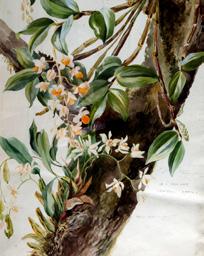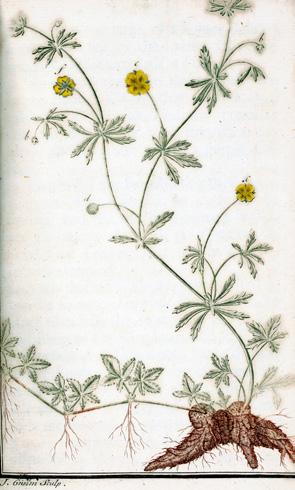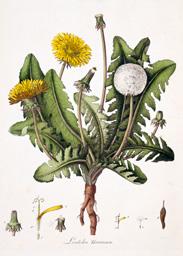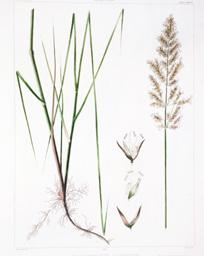
7 minute read
Drawn from Nature
from rhsi spring test
by RHSI Office

Drawn from Nature
The Flowering of Irish Botanical Art
During the last twenty years or so while carrying out research relating to the subject of Irish botanical illustration, I was astonished to find Ireland did not possess a Society of Botanical Artists. Today, I am delighted to say that the Society (ISBA), established March 2014, is flourishing with a healthy membership.
However, it would appear this was not always the case. There is little evidence of botanical illustrators working in this country until the foundation of The Dublin Society, (25 June, 1731) formed to ‘improve husbandry, manufacturers, and other useful arts’. This resulted in members determined to raise standards of agricultural practice. In order to tackle and improve crop cultivation, the Society began to publish a number of statistical surveys and pamphlets relating to a wide variety of crops: saffron, hemp, etc., botanical portraiture playing an important, functional and practical role.
As early as 1732, one of the earliest plant portraits, a small competent hand-coloured engraving of Potentilla anglica (trailing tormentil) by Co. Kildare born artist, James Gwim (Gwin) (1700-1769) appeared in the Society’s pamphlet relating to tanning [1]. Here, the artist conveys information in as highly scientific and accurate a way as possible and demonstrates the vital necessity for accuracy in plant portraiture. The latter is essential as botanists require as much visual information as possible in order to help them to name and identify the plant in question.
Patricia Butler
Born in Blackrock, Co. Dublin in 1869, field geologist and artist George Victor Du Noyer demonstrates how important these skills are as seen in the first publication to arise directly out of the Natural History Section of the 19th century Ordnance Survey of Ireland [2]. This contained eight pages of plant portraits devoted to the botany of the parish of


Templemore, hand-coloured in watercolour by Du Noyer and included the narrow smallreed Calamagrostis lapponica.
Botanical art was and is being used today in a wide variety of fascinating and practical areas including the field of design. Dublin born, William Kilburn, (Capel Street, 1745-1818) succeeded in combining both botanical portraiture and design and made a vital contribution to scientific botany and illustration. Invited by botanist, William Curtis FLS (1746-99) to contribute a number of copper-plate engravings to his Flora Londinensis (London, 1775-98), Kilburn executed a substantial number of hand coloured, life-size plant portraits. Forced to desert the world of botanical illustration for the more profitable business of calicoprinting, Kilburn’s feeling for naturalism did not desert him as displayed in his outstanding ‘working designs for textiles’ [3] which today form part of the V. & A. collections, London.
One of the most fascinating aspects which came to light while carrying out research for my book was the lack of recognition for female botanical artists. Throughout the 19th and into the early 20th century, women, because of their gender were largely confined to working on the margins of academic and

scientific institutions with substantial numbers being drawn to the world of collecting and illustration. Botany was looked upon not as a profession but as a hobby and saw keen female amateurs relying on their observational skills rather than any type of strict, formal scientific training.
Algologist and bryologist, Ellen Hutchins (1785-1815) who lived an isolated existence in Bantry, West Cork where she died in 1815 aged only thirty made a valuable contribution to a number of leading 19th century publications including J. Sowerby and J.E. Smith’s well known English Botany [4] but received little public acknowledgement. Others were pleased to see their work in print but did not actively seek recognition. The Hon. Mary Ward’s (nee King) (1827-1869) (‘Ireland’s first Lady of the Microscope’) studies of insects, fish scales, bird feathers and plants resulted in three publications and all carried the somewhat mysterious attribution ‘The Hon. Mrs W’.
‘A Woman of Substance’, Lady Edith Blake (nee Osborne) 1846-1926) possessed no formal art training in either botany or art yet succeeded in leaving a remarkable legacy. Born in Clonmel, she eloped with, and married Captain Henry Arthur Blake (18140-
1918), a man considered by her family to be highly unsuitable. Later, he went on to have a distinguished career beginning with his appointment as Governor of Newfoundland in 1887. Each new ‘territory’ saw Lady Blake avidly recording the botanical beauty of native plants. Frequently, she despatched seeds and living specimens to Kew as did Lady Charlotte I. Wheeler Cuffe (nee Williams) (1867-1967), whose husband Sir Otway served as a civil engineer in the British Colonial Service. While travelling through remote regions in Burma, this intrepid traveller recorded several hundred botanical paintings which were later presented to Glasnevin (1926). A keen gardener, Cuffe was invited to undertake the design, construction and initial management of the botanical gardens at Maymyo, (now the National Kandawgyi Botanical Gardens), Burma; her aim: ‘to have a garden of all the beautiful indigenous flowers, trees & shrubs ….’ [5].
Today, Ireland is fortunate to enjoy the work of some of the finest botanical artists in the world, the ISBA providing a welcome platform. Poet and naturalist Michael Viney writing in the Irish Times (2003), when celebrating the 80th birthday of his close friend botanical artist, Raymond Piper remarked:
How extraordinary it is, in the age of photography, that precision of this sort should still have such power. ‘Boy!’ commanded Piper’s night-school teacher, ‘make the line live. Give it shape, thick to thin to suggest shape and volume. Give it vitality - make it speak! [6]
‘Drawn from Nature. The Flowering of Irish Botanical Art’ is available from all good book shops.
Notes
[1] William Maple, A Method of Tanning without Bark, Dublin: published by A. Rhames for The Dublin Society, 1732.
[2] Memoir of the City and N. Western Liberties of Londonderry, Parish of Templemore. Colonel Colby. Dublin, 1837.
[3] Book of Designs for Printed Textiles, Title (on spine): ‘Kilburn’s Designs’. Date: c.1787/1792, Victoria & Albert Museum, London.
[4] Amongst Ellen Hutchins’s contributions were: (a) J. Sowerby & J.E. Smith English Botany... 36 vols (London, 1790-1814); (b) Lewis Weston Dillwyn, British Confervae, or, Coloured Figures and Descriptions of the British plants referred by Botanists to the Genus Conferva. (London: W. Phillips, 1802) (c) Dawson Turner, Historia Fuci, sive ... Plantarumfucorum ... et Historia. 4 vols, Latin and English (London, 1808-1819) etc.
[5] Letter from Lady Charlotte Wheeler-Cuffe to Baroness Pauline (Polly) Prochazka (no date) as quoted in E. Charles Nelson, ‘Mount Victoria, Spring, 1911’ in Shadow Among Splendours. Lady Charlotte Wheeler-Cuffe’s Adventures Among the Flowers of Burma, 1897-1921 (Dublin: NBG Glasnevin, 2013), p.110.
[6] Michael Viney, ‘The Orchid Man’, Irish Times Magazine, January 11, 2003, p.10.
List of Illustrations
1 Title: Potentilla anglica (Trailing Tormentil)
Artist: James Gwim (Gwin), (1700-1769).
Courtesy, National Library of Ireland.
2 Title: Calamagrostis lapponica (Lapland Reedgrass)
Artist: George Victor Du Noyer (1817-1869).
Engraving from The Templemore Memoir (Appendix, 2nd ed., Dublin, 1837, plate 4.
Courtesy, National Library of Ireland.
3 Title: Leontodon taraxacum (Taraxacum officinale), Dandelion
Artist: William Kilburn (1745-1818).
Copperplate engraving hand-coloured from an original watercolour drawn for Flora Londinensis.
Courtesy, National Library of Ireland.
4 Title: Dendrobium thyrsiflorum and Coelogyne huettneriana
Artist: Lady Charlotte Isabel Wheeler Cuffe (nee Williams (1867-1967).
Watercolour. Inscribed in watercolour ‘ON HILL OAK
LEIKTHO APRIL’
Courtesy, National Botanic Gardens, Glasnevin, Dublin.

